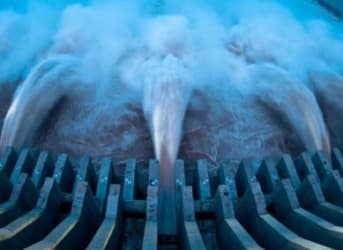For decades, hydropower has been the chief source of clean and renewable energy in the United States, but new federal statistics show that it’s about to be eclipsed by other renewable sources.
A report by the U.S. Energy Information Administration (EIA) shows that April 2014 was the eighth straight month in which “non-hydropower” surpassed hydropower. Solar, wind and other alternatives were responsible for 7.4 percent of total electricity generation, just above hydropower’s 7 percent.
Just 10 years ago, hydropower produced three times more energy than other renewables, according to the report by the EIA, an arm of the U.S. Department of Energy. And by 2013 it was still holding on to the lead: non-hydro sources generated only about 6.2 percent of all electricity in the United States, compared to hydropower’s 6.6 percent.
But the latest data available from the EIA shows that in the first five months of 2014, hydro and non-hydro have switched places. That gap is expected to keep growing because of the continuing decline in the cost of using non-hydro sources, their growing popularity for investors and their annual growth in capacity, combined with a decline in the growth of hydropower.
The EIA concludes that non-hydropower probably will more than double the output of hydropower by 2040.
What’s primarily responsible for the shift is the recent rapid growth in wind and solar power, assisted by mandates from many states to operate generators of renewable fuels to earn tax credits from the federal government.
Meanwhile, depreciation on hardware for hydro plants and rising financing costs to fix or replace them have encouraged a turn to other renewables that are easier and less costly to operate. For example, the average cost for a solar panel has declined by 60 percent since early 2011.
And photovoltaic prices for utilities that generate residential solar power have plummeted from $3.90 per watt in 2009 to $1.85 per watt in 2014, while residential photovoltaic systems are now 28 percent less costly than they were in 2011. Meanwhile, the cost of generating wind power has dropped by more than 40 percent in the past three years.
Hydropower also has been hobbled recently in states struck by long droughts. Prime examples are California, Nevada and Texas. California, once a hydro leader with more than 300 dams providing 14 percent of the state’s electricity for the past 30 years, saw production shrink to 9 percent in 2013.
Meanwhile, wind and solar energy generation have grown in California. Over the past 10 years, they generated only 2 percent and 0.3 percent, respectively, of the state’s electricity. Yet by 2013 wind’s contribution grew to 5.2 percent in 2013, while solar’s share rose to 1.5 percent.
By Andy Tully of Oilprice.com


















